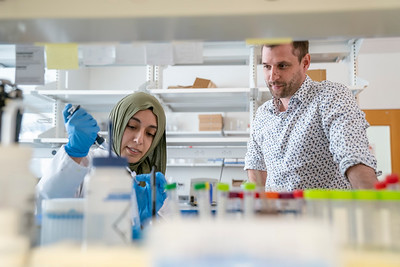In This Story
Four George Mason University researchers are part of a team developing a novel method to develop vaccines rapidly. Their new process takes advantage of DNA molecules’ self-assembly properties by folding them onto nanoparticles that mimic viruses, eliciting a robust protective immunity to COVID in mice. The journal Communications Biology published the findings in March.

Remi Veneziano, an assistant professor, and Esra Oktay, a PhD student, both in the Mason College of Engineering and Computing’s Department of Bioengineering, published the paper along with Farhang Alem and Aarthi Narayanan in the Mason College of Science, collaborators from the U.S Naval Research Lab, and Case Western Reserve University.
“The beauty of this technique is that the design flexibility and the ease of assembly allow users to create nanoparticles with prescribed geometry and size," Veneziano explains. "They are assembled by mixing multiple DNA strands in a tube and by slowly [heating and cooling] them.”
The team took advantage of having a DNA "barcode" of sorts on the surface of the particles to attach antigens precisely at prescribed locations. “All the positions in the structure have a different sequence. Here at position A, you have sequence ‘ATCG,’ for example,” he says, referencing DNA base-letter abbreviations. “At position B you might have ‘CGAT,’ which allows you to modify only specific regions of the nanostructure.”
Having control and predictability of the DNA structure, the team organized multiple antigens—small viral proteins that trigger an immune response—to be a virus copycat with specific application onto the DNA strand. This allowed for an efficient triggering of the immune system, compared to results seen when randomly organizing an antigen. Their results suggest that “we don’t need to pack a lot of antigen on the surface of a particle,” Veneziano says. “We just need to organize the antigen in a specific pattern so that it’s recognized more efficiently by the immune cell.”
Their approach was successfully tested in a mouse model at the Mason Regional Biocontainment Lab within the university’s Biomedical Research Laboratory, one of 12 regional biocontainment facilities funded by the National Institutes of Health’s National Institute of Allergy and Infectious Diseases.
Narayanan says, “The platform is extremely versatile and adaptable in the antigenic possibilities it can present. With the appetite to develop broadly effective vaccines against multiple viruses with pandemic potential, this approach holds major promise.”
Oktay, who is working on a doctoral degree in bioengineering, notes, “During the pandemic we wanted to establish a strategy against COVID-19. We created an innovative and controllable platform using a tour de force of DNA origami technology, which has achieved a significant outcome in the way of protection against viruses.” She says the future goal is “to adapt this platform for other types of viruses for which currently there is no vaccine, and to create a protective system.”
Veneziano indicates the ability to stave off future pandemics is encouraging. “This novel technology has the potential to change the way we currently design vaccine particles by making vaccine development faster, safer, and cheaper.”
